|
Dassault MD 450 Ouragan
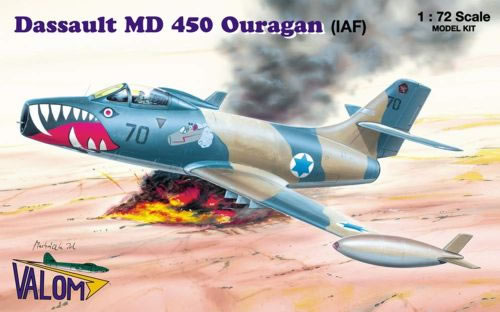
Valom, 1/72 scale
S u m m a r y : |
Catalogue Number: |
Valom Kit No. 72060 - Dassault MD 450 Ouragan |
Scale: |
1/72 |
Contents & Media |
79 x grey styrene airframe parts, 1 x clear styrene canopy, 1 x resin ejection-seat & two resin nose-wheels*, 1 x Photo Etch (PE) fret of small details with printed clear film, and decals for two aircraft.
* Not mentioned in the parts map, see text for explanation. |
Price: |
Available on-line from Hannants for £18.33 and Modelimex for €16.67, (Click here for currency conversion) |
Review Type: |
First Look |
Advantages: |
Good cockpit detail for the scale, underwing weapons included, good decals and useful multiple cross-referencing of colour call-outs. |
Disadvantages: |
All three wheels are misshapen. The French scheme’s red nosed tip-tanks would have benefited from having segmented decals provided, as they will be challenging to mask and paint. My personal view is that the riveting is excessive and the speed-brakes would have been better moulded closed. |
Conclusion: |
Good cockpit detail, weapons and decals are definite pluses. The very fine engraved surface detail has masses of rivets that some will love and others hate. Some will see it as an improvement on the Heller kit, although this conclusion will probably depend to a large degree on your view of rivet detail in 1/72. I regard them as unrealistic. Misshapen wheels are unexpected in 2011 and should have been better resolved prior to the kit’s release. Despite these criticisms it is still a worthwhile kit that offers a clear alternative to the only other option in 1/72 scale from Heller. |
Reviewed by Mark Davies

Valom's 1/48 scale An-2 Colt is available online from Squadron.com
Background
Marcel Bloch adopted his nom de guerre of Dassault after release from Buchenwald concentration camp in 1945, and re-entered the aviation industry in 1946. He formed Avions Marcel Dassault and set about designing a jet fighter in 1947. This was something he believed could and should be achieved, despite French aircraft design having stagnated since 1940 due to occupation and the war in general. Some staggering advances had been made in these intervening years, including jet engines and swept wings. French aviation clearly had a lot of catching up to do.
Marcel Bloch’s last fighter had been the radial-engined MB 157, a development of the MB 150/152/155 line stopped short by Germany’s victory in the Battle of France. Marcel Dassault began his new fighter design in 1947 and planned it to use a licence-built version of the British Rolls Royce Nene. At the time this was one of the most reliable and powerful engines available.
Within 15 months the prototype Ouragan (Hurricane in English) made its first flight in February 1949. However there had been a flurry of design activity from a number of French designers post-war, all eager to exploit the new jet engine technology. The honour of first indigenous jet fighter to fly went to the Sud-Ouest SO 6020 Espadon, a rather strange looking machine also powered by a Nene. It had a number of intake-related problems and lost out to Dassault’s Ouragan for a production contract.
The Ouragan was accepted for French service and began to replace the Vampire in 1952. But by 1955 the Ouragan in turn was facing replacement by the swept wing Dassault Mystere IVA and Republic F-84F Thunderstreak; such was the pace of progress in the 1950’s. However some French Ouragans served until the early 1960’s.
India procured 104 Ouragans and renamed the aircraft Toofani, this name being the Hindi equivalent of Ouragan. The first Toofanis arrived towards the end of 1953 with most of the balance arriving in 1954. By 1957 the Toofani began to be replaced by the Mystere IVA and subsequently the HAL Ajeet (a licence-built Folland Gnat).
The other Ouragan operator of the 1950’s came about by default. Egypt had concluded a major arms deal with the Eastern Bloc, which included MiG-15’s, and Israel recognised the need to urgently update its inventory in response to this. In particular it needed to improve its jet fighter force that was equipped with Meteors.
Planned procurement of Sabre 6’s from Canada fell through as a result of an arms embargo. However the French were happy to supply the Israelis with Mystere II’s, but they chose to wait for the superior Mystere IVA’s instead. However a stopgap was needed, so at least 75 Ouragans were acquired from Dassault production and retired French air force stocks, pending delivery of the Mystere IVA’s. Ouragan deliveries were completed in 1955. They were successful against both Egyptian Vampires and even MiG-15’s on one or two occasions (mainly because the MiG’s were not flown to their full potential whereas the Ouragans were). The Ouragans stability as a gun platform ensured that it performed very well in the ground attack role, and it stayed in service well into the 1960’s.
El Salvador decided to upgrade its air force following the 1969 “Football War” with Honduras. A US arms embargo led them to seek aircraft from further afield than usual and resulted in a deal to purchase refurbished Israeli Ouragans. They were used extensively in the civil war of 1980-92, mainly in short-range ground attack missions without tip-tanks in order to carry greater offensive payloads. Unlike the previous three histories, where Mystere IVA’s replaced Ouragans, Cessna A-37’s superseded the El Salvadorian Ouragans after the Reagan administration dropped the US arms embargo.
Previous Ouregan Kits
The Ouragan has not been widely represented in kit form. I’m aware of a single1/72 scale injected kit from Heller, and a 1/48 scale resin/multi-media offering from JM. Goutte-Toquet. Heller’s kit is typical of this brand’s better offerings, despite being several decades old. It has crisp mouldings, with sparse and fairly fine raised surface detail, and goes together well. The JM Goutte-Toquet kit has a couple of fit niggles, but a nice model can result according to SAM Vol 20 No2 (April ’98). So it could be said that we have been overdue for a more modern injected iteration of this fairly significant early French jet.
My articles usually focus from this point on the review kit alone. However in this case I will be making some reference and comparison to the Heller kit from time to time. I have done so because I assume that many will regard the Heller kit to still be a fairly decent offering. If I’m correct, then I further assume that some interest will lie in what Valom has to offer compared to Heller. With only two 1/72 Ouragan kits to choose from, and a reasonable price difference, I think that this approach is reasonable.
The kit comes in Valom’s standard and adequately sturdy top-opening box with artwork showing an Israeli Ouragan its definitive ground-attack role. The contents are sealed in a cellophane bag, with the clear parts, resin seat, PE and decals further sensibly protected in their own little bags.
The instructions are to Valom’s usual adequate standard, printed on glossy paper and folded to form a booklet. However a stand-out feature of Valom instructions is their cross-referencing of colours to FS 595B, and the paint ranges of Humbrol, Agama, Model Master and Gunze Sangyo. There is an aircraft history in both Czech and English. The parts map soon reveals that a fair amount of ordnance is included, something that is lacking in the Heller kit. Part numbers 15 & 16, the wing tips, are crossed out. These are obviously for the El Salvadorian issue (#72068) which also has Indian markings. As an aside, there is another boxing which also features French and Israeli markings options (#72059).
I was unsurprised to find an almost perfect agreement between Valom’s and Heller’s dimensions and shapes. So for purists of line and dimensions there is very little to distinguish one from the other. But there is a distinct contrast in style and approach to both cockpit and surface detail. As you’d expect from a Czech limited run kit there is an improvement in interior detail compared to the preceding mainstream kit. The combination of a more detailed tub, resin seat with PE belts and PE instrument panel all make for a nicely done pit in this scale. The real contrast between the two is the approach to surface detail.
As you’d expect, Valom’s kit has recessed surface detail. But as has become characteristic of their more recent kits it is also awash with recessed rivets (not that they are alone in this respect).
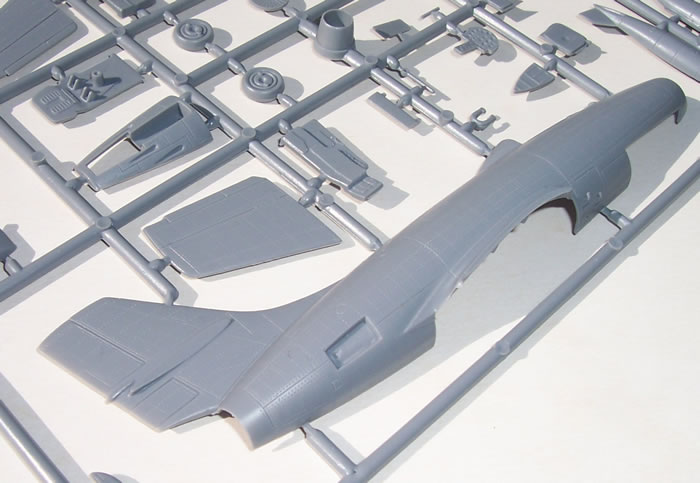
In previous Valom reviews I have expressed my doubts about the appropriateness of multitudes of rivets in 1/72 scale, albeit that Valom’s rendering of them is very refined. For some reason there just seem to be too many with this kit; they’re everywhere. The surface is effectively a checkerboard of dotted lines 3 or 4-mm apart. Being a limited run kit there is likely to be some seam filling and sanding, and so fine are the rivets it will take a deft hand to replicate them in areas where detail is lost. Under camouflage paint they may look okay, but I suspect that with a natural metal finish the rivet lines will look overbearing.
Also extreme care will be needed with panel-line washes, as any overflow into the rivet lines could look totally overdone. So before proceeding any further - If you don’t like rivets everywhere buy the Heller kit, you can always re-scribe if you want recessed panel-lines. I’ve looked closely at enlarged walk-around images of weathered Ouragans and, with the exception of one or two key areas, rivets are barely visible, if at all, in most places.
Well enough of beating the anti-rivet drum, let’s look at the rest of the kit.
Parts breakdown is conventional for this type of aircraft. A nose intake occupied by ducting enclosing the nose-wheel well means few places to place ballast in the nose. The instructions provide no guidance on this matter, but obviously ballast will be needed to avoid having a tail-sitter. Just behind the rear cockpit bulkhead may be best.
The cockpit is well catered for given the scale and a closed canopy. There is a PE instrument panel with film, a tub made of four styrene pieces with floor and sidewall detail, control column and resin seat with PE belts.

There is a styrene instrument panel with recessed holes for gauges for those who do not like PE. A clear styrene gun-sight tops things off.
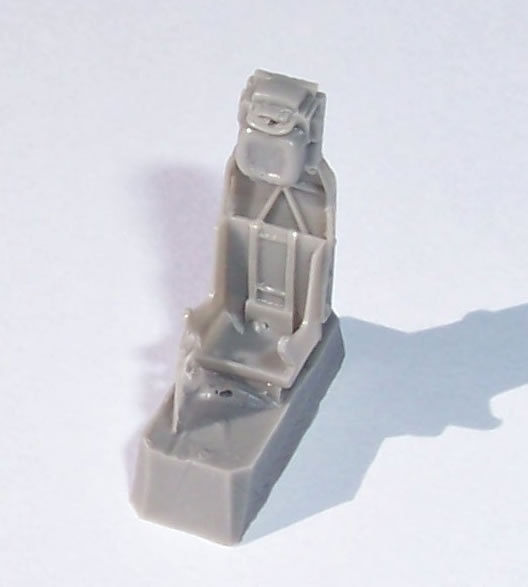
The canopy is par for kits of this type, not super-thin, but not too distorting either. It will benefit from a lick of Future to brighten it up a bit.
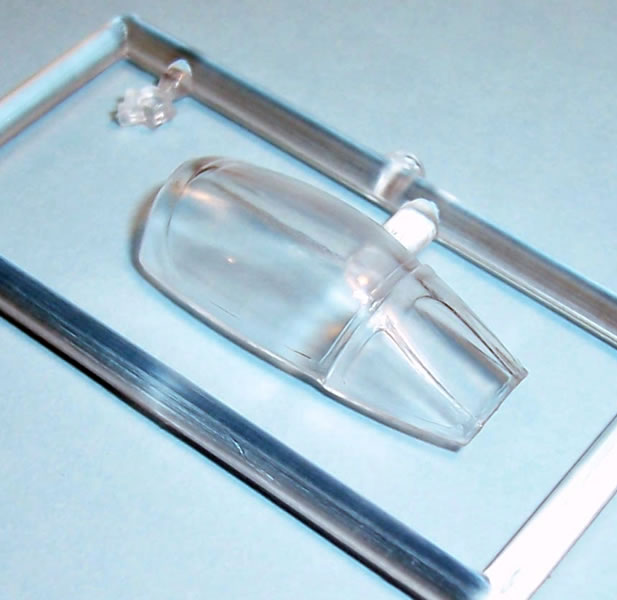
The intake ducting has no nose-wheel well detail, but this is a minor point as little will be seen. The exhaust nozzle has a turbine face to close it off. Once these two assemblies, plus the cockpit and ballast are inserted in the fuselage halves there’s not a great deal left to assemble. The rudder’s trailing edge might benefit from some thinning before this however. The cannon ports and nose-wheel opening are moulded in a separate section that fits into a cut-out in the fuselage under the cockpit. The cannon ports are reasonable, but most will want to drill open where the ends of the barrels sit.
Unlike Heller’s kit, this one has the speed-brakes moulded separately. Personally I’d prefer they were moulded shut, unless the aircraft always has these deployed on the ground (like the SAAB Lansen for example). This is because with a few exceptions they rarely fit neatly when closed. If you do model the doors closed it can be a real pain dealing with poor fit and gaps, not to mention trying to re-scribe along a plastic weld line. In the case of a limited run kit like Valom’s Ouragan, it’s almost guaranteed that the fit will not be as precise as required here. Moreover, I checked numerous images of parked Ouragan and all had their brakes closed.
The wings have a central insert that provides the main wheel wells with a modicum of detail present. Many will wish to thin the trailing edges of the three-piece wings. The tip-tanks are halved with a separate fin, and will need some care in the aligning on all axes. The horizontal stabilisers are each moulded as one piece.
When comparing the two 1/72 kits, I feel that Valom’s recessed lines around control surfaces and flaps were just a bit more delicate and crisply defined than Heller’s. Whilst the fuselage joint-line for engine access is distinctly better with Valom in this regard, as the Heller’s joint is quite exaggerated.
Unlike the Heller kit, Valom’s comes well armed. Four rails of two-tier rockets and two bombs and their pylons serve to emphasise the type’s ground attack mission. Yes the fins on the moulded rockets are a little thick, but most builders will live this I think.
The undercarriage is done well enough for low-pressure moulding, and features PE scissor-links if you choose to cut off the moulded ones. The main-wheels are sufficiently detailed but a little out of round. To some extent this can be disguised as weight on the tyre, but the nose-wheel tyre is badly misshapen. Such problems can arise due to tooling limitations with limited-run kits. It would have been better to supply all three wheels correctly mastered in resin.

Two resin wheels were provided with my kit presumably to replace the faulty styrene nose-wheel (although one is of course sufficient). There is no mention of these parts on the parts map or in the instructions. I assumed the resin items are a nose-wheel replacement as they are much smaller than the main-wheels. The resin wheel is different to the styrene nose-wheel in shape and hub detail, and looks like a last minute fix using a generic wheel that is close to the right diameter as a master. The rim is too big although the tyre is the right diameter, but sadly it is also out of round (although this is not so apparent in the images accompanying this review).
How buildable will the kit be? Well Valom does not have a sterling reputation for precise fit, and it is limited-run technology, so there are likely to be some adjustments, trimming and filling needed. However the kit itself is relatively simple parts-wise. My guess is that the challenges may lie with fit and adjustment of the cockpit and intake trunking into the fuselage, and closing the speed-brakes if you choose to do so. The other challenge will be to take care of liquid cement runs and seam filling and sanding, as all three will potentially eliminate the very fine surface detail.
There are French and Israeli decal options, these being Armee de l’Air, ? 154 L’EC 2/4 “La Fayette”, and Chel Ha’Avir ? 70 113 Sqn (Tajeset). The French scheme is overall aluminium with red-nosed tip-tanks, where the red tapers into four trailing points. This will be hard to mask, and I think that segmented decals could have been provided.
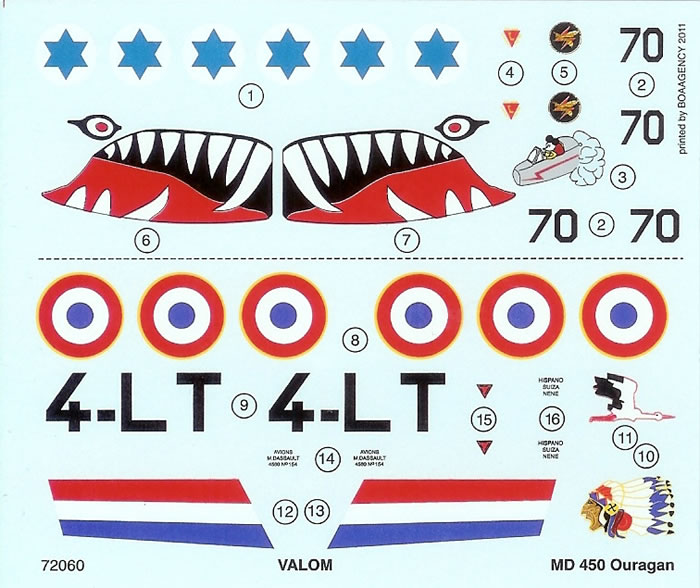
The Israeli scheme has camouflaged Blue-Gray and Light Earth upper surfaces over Pale Blue undersides. It features huge gaping red and black mouth with large white teeth. The decals appear well printed with fine detail and good registration. They are glossier and perhaps a bit thinner than Heller’s, but Heller’s are finely printed and registered as well.
A new release of an old previously kitted subject usually heralds a real advance, but in the Ouragan’s case the Heller kit is still a pretty good. So the improvement is more modest than, for example, with Valom’s Hampden kit compared to its Airfix forebear.
Obvious improvements are the level of cockpit detail, the weapons load, and alternative wing-tips. Decal quality is a bit better than Heller’s too, although Heller’s aren’t at all bad either. The very fine recessed detail and option of open speed-brakes could be seen as pluses too depending on you viewpoint. I’m happy with the kit’s recessed panel lines, but not the plethora of rivets. Beautifully done they may be, but they just aren’t so apparent on the real thing. I think they may look overbearing with an all aluminium scheme, and may be challenging to restore after seam filling and sanding. As to speed-brakes, especially with limited run tooling, I prefer mine moulded shut every time unless the subject is one of the few types to have deployed brakes when parked.
Rivets and speed-brakes aside, there is little to complain about other than the wheels. The out of round main-wheels are not the best but can probably mounted thin side downwards to simulate a weighted tyre. The replacement resin front wheel could have its bulged side re-shaped, although the rim will still be a little large. Valom should have done a better job of resolving this issue prior to the kit’s release in my view. Five to ten years ago such faults were often accepted as par for the course with limited-run kits, but no longer I think. Now decent resin items are the expectation when limited-run styrene parts are not up to the job.
So yes, Valom’s kit is an improvement on the Heller’s, but it’s maybe a case of two steps forward and one and a half backwards. I suspect it will be a little harder to build in terms of fit and preserving surface detail (although keeping Heller’s few raised lines could also offer challenges). Which you choose to build will be down to budget, cockpit and surface detail preferences, decals and weapons choice (and perhaps in Heller’s case, availability too). If it were not for the Heller kit’s lack of weapons, on a pros and cons tally up, I’d place the Valom and Heller kits about equal.
I have no doubt that before long we will be seeing some very nicely finished Valom Ouragans in the various modelling web-sites and magazines. I can recommend this as a worthwhile kit, but subject to individual preferences about the copious rivet detail.
Thanks to Valom for the review sample.
Review Text and Images Copyright © 2011 by Mark Davies
Page Created 2 August, 2010
Last updated
2 August, 2011
Back to HyperScale Main Page
Back to Reviews Page

|
